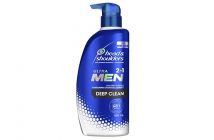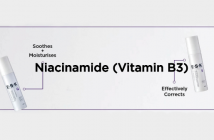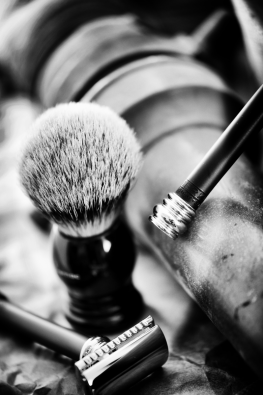
How did it come to be that we started getting shaving advice from tennis players, golfers and footballers?
Learning to shave was once a wonderful tradition passed down from father to son with tips and techniques, and a sense of style and occasion. Now we have battery powered razors with built-in microchips to control the five blades as you combine it with your specially formulated shave gel in a can … and … well … I’m a little confused.
It may not be quite that dramatic, but there is something quite wonderful about the traditional wet shave and, in some circles, it is making a comeback.
Those who partake in the old tradition will swear it provides a better and cleaner shave than new disposable razors – and there is no doubt that there can be considerable cost savings as well. And as an added little bonus … you just feel cool when you do it.
We spoke to someone from Men’s Biz – a fantastic supplier of a whole range of grooming products for men – plus he’s a bit of fan of the classic wet shave. He was good enough to offer his knowledge and experience so we can all shave like our grandfathers.
The first thing we should note here is that we’re talking about a double edge razor – not the straight razor more closely aligned to gangster movies and nasty barbers from Seville. While still containing a sharp blade that can cut, the double edge razor is far more easy to use than the ‘cut throat’ and, therefore, more accessible to all of us mere mortals.
He was good enough to give me a personal lesson and the opportunity to understand this brilliant ritual. While handling a sharp blade around your face is never a good time to be thinking about something else, it did promote a number of questions.
Where did the double edge razor come from?
The double edge razor (also called the safety razor) has been around for a long time. It was the natural next step in the evolution of the shaving process. Men had gone from carving their whiskers with sharpened obsidian rocks, gradually evolving to the straight razor, and next, to the double edge. In the early 1900s, King C. Gillette, founder of the company with the same name, wanted to create a shaving tool for men that had replaceable blades, but was still effective and provided a great shave. Thus, the double edge razor was born!
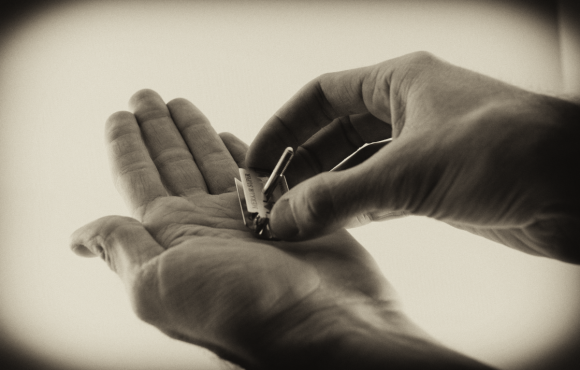
I’ve already got a razor… why would you still use a double edge today?
A double edge razor offers a number of advantages over a cartridge razor.
The primary benefit is that it simply offers better results. Cartridge razors (with their multiple blades) use a tug-and-cut approach that can cause razor bumps, irritation, and general discomfort. A double edge razor has a singular blade and cleanly shaves off hair shafts with each pass, without pulling and tugging them. This means less bumps, less irritation, and a closer shave.
Cost is another big factor. Double edge razor blades can be as inexpensive as 20 cents each, while cartridge razor blades can run anywhere from $4 to $8 – you’ll save a lot in the long run.
Also, the shaving experience with proper wet shaving gear and a double edge razor is a tremendously enjoyable one. We hear from men all the time who are dissatisfied with their current shave and find the process a chore. When they change over to traditional wet shaving with quality equipment, they realise shaving can be really, really enjoyable. It’s a lot more hands on, visceral and involved. It’s something that we find many men really like – it’s comparable to changing your own tyres or working with your hands; it’s a skill. You’ll get better at it as you put more time into shaving with a double edge razor, and it’s a talent you’ll carry with you for life.
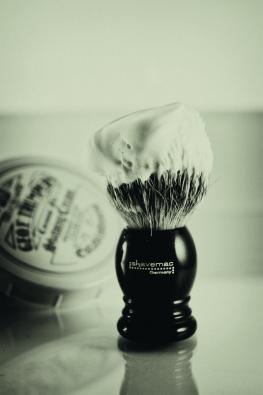
What about the accessories?
The essential items of a traditional wet shaving kit include a shaving brush, a shaving cream or soap, a double edge razor, and double edge razor blades.
Shaving brushes are used to whip up a shaving cream or soap into a thick, rich lather and then apply it to your beard. They come in a few options, differentiated by the material used for their bristles. There are boar brushes that are inexpensive and coarser, which are better suited to shaving soaps than shaving creams. The next step up is badger brushes, which come in three different and increasing quality grades (pure, super, and silvertip). Badger brushes generally retain more water than boar brushes and are softer, making it easier to generate good lather and offer a more pleasant shaving experience. There are also brushes with bristles made of synthetic fibres for those averse to animal products.
Shaving creams and soaps are used to generate shaving lather – soaps are harder in consistency than creams and tend to last longer, while creams are softer and easier to lather. The lather produced with a good shaving cream or soap is huge improvement over shaving foam or gel from a can. It’s richer, more protective for your skin, and doesn’t have a bunch of nasty chemicals in it.
The double edge razor is pretty standard among manufacturers in terms of form factor but there are slight differences between razors. There are different opening styles (the mechanism enabling the blade to be slotted into the razor), different comb styles (the ‘safety’ part of the blade determining the angle that the blade slices your beard), different weights and different handle lengths. The best razors come out of Germany.
There’s an myriad of double edge blade manufacturers – Astra, Derby, Feather, Merkur and Personna to name a few – and which is best for you is pretty much down to personal preference. They vary in terms of sharpness and cost. Finding one well suited to your beard and skin is best done by trying a few different brands and going with what you like.
[So now I’ve got everything… how do I use it all?
This is the fun part!
First things first: pre-shave prep is pretty crucial, so you’re best off starting with a hot shower. If you’re short on time or want a more ‘barbershop’ experience, soak a towel in hot water, wring it out, and let it rest on your face for a few minutes. This will soften the bristles of your beard hairs and enable your razor to cut through them cleanly.
Next, it’s time to load up your shave brush – start with a brush that’s damp (with hot water), but not dripping wet. For shaving soaps, rub the bristles of your brush into your soap in a circular motion – you’ll know you have enough soap on the brush when the tips of it clump together with the soap on them. You want a soft, creamy texture, not foamy bubbles or a thick paste. Then, transfer it to a bowl, mug, your hand, or beard, and gradually add dribbles of water and swirl your brush. The desired end result is a lather that isn’t too bubbly or dripping but is rich and creamy – like the head on a Guinness (Ed note: good analogy to me…).
The process is similar if you’ve decided to use a shaving cream. Use a damp brush, and add an almond sized amount of shaving cream onto the brush. Then swirl it in a bowl, mug, on your hand or on your face – again, looking for a rich and creamy lather that isn’t too bubbly. Apply the lather to your beard generously and cover all areas that you want to shave.
After that, it’s time to actually shave. Don’t rush this – especially at first – there are no points for finishing first and you’ll just end up with a sloppy shave and some stinging nicks. You want the double edge razor to slice at approximately a 30° angle from your face.
For your first pass, go with the grain – for most men that’s downward on your cheeks and upward on your neck. It’s probably a good idea to get a feel of how the grain on your beard is directed before you actually start shaving. Use very little pressure; the weight of the razor will do all the work for you in that regard. Once you’ve shaved all your desired areas, rinse your face and razor in warm water. You can then re-apply lather and make another pass – with the grain again if you’re a beginner, or against the grain if you’re feeling more confident.
When you’re done, wash off your face with cold water, rinse out your brush and your razor. If you’ve got any after shave balms now is the best time to use them – they’ll help reduce razor bumps and irritation.
So there you have it – another ‘lost art’ that’s not lost yet. I’ve been going with the classic wet shave for a couple of weeks since I met up with Raag and can genuinely say it’s been fantastic for my skin. As he says, less irritation, a cleaner shave and, most of all, shaving has become enjoyable again.




